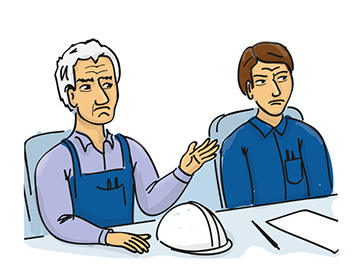Which measurements should I take?
The most common question is what should I start to measure and what do these numbers tell me? Is it a good number or a bad number? What are acceptable vibration values for my machine? What are the limit vibration values which my machine should not exceed?
Let’s go back to low frequency and high frequency vibrations and talk a bit about vibration limits.
Limit Vibration Values
There are some limit vibration values which can be considered as values indicating a worsening machine condition. We can set up the limits according to some experience with certain machines and there are also for example ISO 10816-3 standards for those limit values.
Low Frequency Vibrations
All mechanical faults which are related to the speed of the machine such as unbalance, misalignment and mechanical looseness are considered as low frequency vibrations.
These vibrations are measured as velocity in mm/s or inches/s. (Note: Maybe you are asking now how you can measure velocity with an acceleration sensor? With an acceleration sensor you measure an acceleration value, but the meter (analyzer) can convert the value to the velocity value). The most common frequency range of this measurement is 10 – 1000 Hz. This frequency range is also applied on ISO 10816-3 standards. These standards take into account the size of the machine and its foundation. See the Vibrio M manual to find out ISO vibration limit values.
Adash has defined vibration limit values which are related to the speed of the machine (not to the size of the machine). The frequency of 10-1000 Hz is also applied. See the Vibrio M manual to find out Adash vibration limit values.
Notice: Whether we use ISO or Adash vibration limit values, they are just informational. You should always try to find out what the vibration limit values for your particular machine are . In other words to find out what the optimal operational condition of your machine is. You can do that by measuring and comparing more machines of the same type (running at the same speed and under the same load). Or you can ask a vibration diagnostician who should be able to make a deeper analysis of the machine and tell you if the machine is running under its optimal condition.
Attention! Do not assume that a newly installed machine runs under its optimal condition! What if it was badly installed? It could be misaligned or unbalanced right from the beginning!
Overall velocity measurement
This way we came to the conclusion that to monitor mechanical vibrations (related to the shaft speed) of the machine we will use the measurement of Overall Velocity in mm/s (or ips) in the range of 10-1000 Hz. We call this measurement a Static value as it is represented by one number. Using Adash DDS software we can trend this value in time and see its development.
High Frequency Vibrations
A specific part of the machine which we want to monitor is a bearing. Bearings generate vibrations on higher frequencies due to their construction.
These vibrations are measured as acceleration in a “g” value. The frequency range of this measurement may vary a lot and you should find out what would be the best for your particular bearing. But let’s keep it simple and define your measurement of acceleration in the range of 500 – 16000 Hz.
Adash has defined bearing vibration limits related to the speed of the machine again. The mentioned frequency range of 500 – 16000 Hz has been applied. See the Vibrio M manual to find out Adash bearing vibration limit values.
Notice: Even if we have Adash bearing vibration limit values, they are just informational. Adash limit values were created on the basis of more than 30 years of experience of Adash field engineers. During those years, they measured an uncountable number of bearings, they have seen a lot of measurements from customers who were using Adash systems. According to this, Adash has done some measurement averages and created vibration limits for bearings which should warn you of failure in advance.
General bearing vibration limits do not exist. Why?
Imagine that there is many thousands bearing types on the market, therefore you can not define general vibration limits. Also you have to consider that each bearing on a particular machine runs under a different speed and a different load. Another aspect is how the bearing was installed in the machine.
Notice: It is recommended to try to find out what the vibration limit values for your particular bearing are. In other words to find out what the optimal operational condition of the bearing is . You can do that by measuring and comparing more bearings of the same type (running at the same speed and under the same load). Or you can ask a vibration diagnostician who should be able to make a deeper analysis of the bearing and tell you if the bearing is running under its optimal condition.
Overall acceleration measurement
Therefore the second measurement which we will include in our regular machinery measurment will be Overall Acceleration in g in the range of 500 – 16000 Hz. It is again a Static value as it is represented by one number.
Summary
There are two important values which we should measure regularly on our machines:
- Overall Velocity in mm/s (inch/s) - lower frequency range - which indicates the general machine condition
- Overall Acceleration in g – higher frequency range – which indicates the bearing condition
Notice: Maybe you are asking why we use different units (velocity and acceleration) for those measurements. Simply said, the acceleration is more sensitive to high frequency vibrations and the velocity is more sensitive to lower frequency range, so it has become common to use those two units as they are the most effective for vibration diagnostics.




